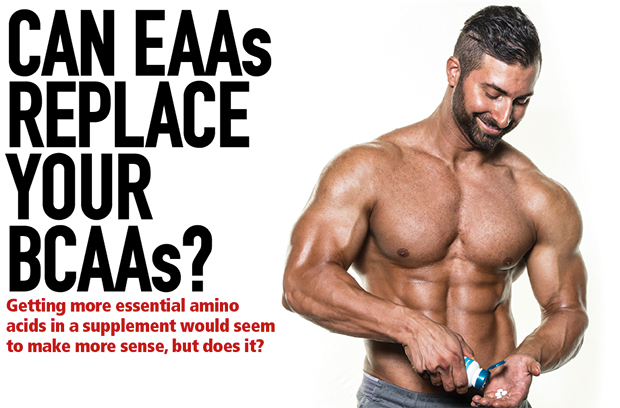Are EAAs Better Than BCAAs?

Getting more essential amino acids in a supplement would seem to make more sense, but does it?
Branched-chain amino acids (BCAAs) have become popular among bodybuilders for both their anabolic and anti-catabolic properties. A BCAA consists of three essential amino acids: L-leucine, L-valine, and L-isoleucine, which are typically most effective in a 2:1:1 ratio (2 leucine to 1 valine and 1 isoleucine).
These amino acids are called branched chain because they have an aliphatic side-chain with a branch (or what in chemistry we call a central carbon atom bound to three or more carbon atoms).
When you exercise, these amino acids are preferentially spent first (that is, used for fuel, or energy purposes, when your body is in a glucose-deficient state rather than your body stripping the nitrogen atom from any other amino acid). Therefore, the quicker you replenish them, the quicker you recover. I also always recommend taking them beforeworking out so they’re on hand in advance.
Today you see essential amino acids (EAAs) on the market, which have all nine essential aminos instead of just three. Naturally, more questions arise: Are EAAs better than BCAAs? What exactly are they? Do they work differently?
Your body cannot make essential amino acids, so you must consume them from external sources. Besides the three BCAAs, EAAs also contain histidine, lysine, methionine, phenylalanine, threonine, and tryptophan.

Remember, amino acids are the main building blocks of muscle and come from protein. Your body must first break down and separate protein from fat and carbohydrates. Next, it further breaks down the protein into amino acids so they can be absorbed and then reassembled into building muscle.
In all, your body uses 20 different amino acids to grow properly. While nine are considered essential, another 11 (called nonessential) are made within your body on its own from raw materials you’ve consumed. Simply put, you need all 20 amino acids present to efficiently grow muscle.
Each of these nine essential aminos plays a specific role in within the body:
- Phenylalanine plays a role in the production of other amino acids, as well as protein and enzyme function.
- Valine stimulates muscle growth along with regeneration.
- Threonine plays a role in fat metabolism and immune function. It’s also part of the structural proteins such as collagen and elastin.
- Tryptophan helps maintain a positive nitrogen balance and is a precursor to serotonin.
- Methionine is needed for tissue growth while assisting metabolism.
- Leucine aids protein synthesis and muscle repair along with helping to regulate blood sugar.
- Isoleucine supports muscle metabolism along with immune function and energy regulation.
- Lysine aids protein synthesis along with hormone and enzyme production.
- Histidine produces histamine and maintains the myelin sheath.
So why would you need a supplement if you can get EAAs from eating protein-rich foods? The main reason is their speed of absorption. Think of pure or free-form aminos as being predigested and ready to be absorbed in about 15 minutes or so, depending on the quality and the product’s delivery system.
Today some companies are claiming that EAAs are the “new” BCAA. However, this is far from the truth. For example, BCAAs are most effective when taken alone, and without other amino acids, in a 2:1:1 ration. BCAAs are also great for recovery and muscle preservation during a diet. On the other hand, EAAs are similar to a high-quality, complete protein source for muscle development and should be taken post-workout or between meals to augment the supply of aminos your body doesn’t produce.
In the end, which is best? The simple answer is both. And that’s why I recommend using both to achieve your physique and performance goals.

